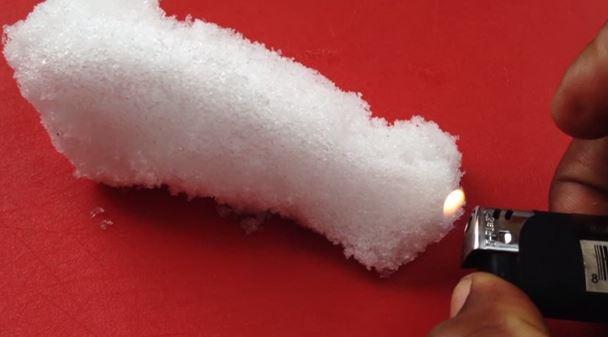Reports of fake snow--which is described as “plastic” and “geo-engineered”--that doesn’t melt and actually turns black when lit on fire are going viral on January 30. The occurrences are being reported in multiple states, including Georgia, South Carolina, and Virginia.
“It smells like burnt plastic,” said one YouTube user after attempting to light some of the alleged fake snow on fire.
On some of the videos, the snow appears to be some sort of Styrofoam.
Some people are claiming that the so-called fake snow--which people are picking up off the ground outside their homes--is really nanobots.
One person said in an anonymous email to conspiracy website Before It’s News said: “I tried it. I have no BIC lighter so I used a match. Yes, it DID turn black but did somewhat melt. Put in micro wave and did melt. Snow left in the dish to melt, is NOT melting.
“Bottom Line- We have multiple instances of the same type of experiment, conducted by different people, with the same results,” wrote the poster on the website.
However, others have taken to YouTube to post videos claiming to debunk the fake snow reports.
“Bottom line, if you don’t want to waste 5 minutes watching this video, butane burns dirty. The smell is not from the snow, the black on the snow is not because its plastic; it’s because of the butane,” said one such user.
It appears that what’s happening could be sublimation, a term that means “the conversion between the solid and the gaseous phases of matter, with no intermediate liquid stage,” according to the U.S. Geological Service.
Steve Ackerman, a professor of atmospheric and oceanic sciences at the UW-Madison, explained to the Wisconsin State Journal that snow sublimates in a process that is similar to evaporation.
“Whenever there is an interface of air and water, either liquid or solid, you have molecules trying to leave the water,” he said. The constantly vibrating molecules in a liquid or solid are restrained but a water molecule will escape the water and enter the air when it moves violently enough. “We call that evaporation from a liquid, and sublimation from a solid,” Ackerman said.
Sublimation is obvious in the freezer, where ice cubes sometimes shrink with time, or in snowfields, which eventually waste away without melting.
“You notice there’s no liquid water, none of the hard ice that results from melting and refreezing, but the snow still shrinks,” Ackerman said.
To see the effects of sublimation, people can take frost from the freezer and hold it over an open flame.
A refrigeration technician from Canada remarked on Reddit that he deals with ice and frost build-up all the time. “I can tell you from experience that it takes a [long ] time to melt snow and ice with fire. I could see that the snow ball was melting [in the video], just at a very slow rate. As for the fact the water wasn’t dripping off, it was soaking into the snow ball. To do a true test of the snow try filling a pail with snow and fill it with cold water, stir it around until you have a slush and put a thermometer into the mix. If it reads 32F or 0C you can prove it is snow. Keep in mind it does have to be a water/snow mix.”
Additionally, the reports of snow turning black when burnt are likely from areas that have higher emissions of black carbon in the air.





